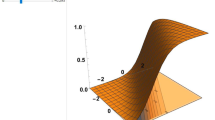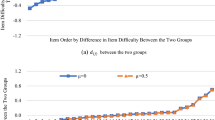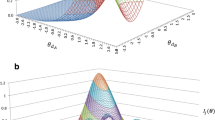Abstract
A method for analyzing test item responses is proposed to examine differential item functioning (DIF) in multiple-choice items through a combination of the usual notion of DIF, for correct/incorrect responses and information about DIF contained in each of the alternatives. The proposed method uses incomplete latent class models to examine whether DIF is caused by the attractiveness of the alternatives, difficulty of the item, or both. DIF with respect to either known or unknown subgroups can be tested by a likelihood ratio test that is asymptotically distributed as a chi-square random variable.
Similar content being viewed by others
References
Baker, F. B. (1977). Advances in item analysis.Review of Educational Research, 47, 151–178.
Berk, R. A. (1982).Handbook of methods for detecting test bias. Baltimore: The Johns Hopkins University Press.
Binet, A., & Simon, T. (1916).The development of intelligence in children. Baltimore: Williams & Wilkins.
Bishop, Y. M. M., Fienberg, S. E., & Holland, P. W. (1975).Discrete multivariate analysis. Cambridge, MA: MIT Press.
Bock, R. D. (1972). Estimating item parameters and latent proficiency when the responses are scored in two or more nominal categories.Psychometrika, 37, 29–51.
Clogg, C. C. (1981). Latent structure models of mobility.American Journal of Sociology, 86, 836–868.
Cressie, N., & Holland, P. W. (1983). Characterising the manifest probabilities of latent trait models.Psychometrika, 48, 129–142.
Eggen, T. J. H. M., Pelgrum, W. J., & Plomp, Tj. (1987). The implemented and attained mathematics curriculum: Some results of the second international mathematics study in the Netherlands.Studies in Educational Evaluation, 13, 119–135.
Goodman, L. A. (1978).Analyzing qualitative/categorical data: Loglinear models and latent structure analysis. London: Addison Wesley.
Green, B. F., Crone, C. R., & Folk, V. G. (1989). A method for studying differential distractor functioning.Journal of Educational Measurement, 26, 147–160.
Haberman, S. J. (1979).Analysis of qualitative data: New developments, Vol. 2. New York: Academic Press.
Hagenaars, J., & Luijkx, R. (1987).LCAG: latent-class models and other loglinear models with latent variables (Working Paper 17). Tilburg: Tilburg University.
Holland, P. W., & Thayer, D. (1986).Differential item performance and the Mantel-Haenszel statistic. aper presented at the Annual Meeting of the American Educational Research Association, San Francisco.
Kelderman, H. (1984). Loglinear Rasch model tests.Psychometrika, 49, 223–245.
Kelderman, H. (1988).An IRT model for item responses that are subject to omission and/or intrusion errors (Research Report 88-16). Enschede: University of Twente.
Kelderman, H. (1989). Item bias detection using loglinear IRT.Psychometrika, 54, 681–697.
Kelderman, H., & Macready, G. B. (1990). The use of loglinear models for assessing differential item functioning across manifest and latent examinee groups.Journal of Educational Measurement, 27, 307–327.
Kelderman, H., & Steen, R. (1988).LOGIMO I: Loglinear item response theory modeling. Computer manual, University of Twente, Department of Educational Technology.
Lazarsfeld, P. F., & Henry, N. W. (1968).Latent structure analysis, Boston: Houghton-Miffin.
Lord, F. M. (1980).Applications of item response theory to practical testing problems. Hillsdale, NJ: Lawrence Erlbaum.
McHugh, R. B. (1956). Efficient estimation and local identification in latent-class analysis.Psychometrika, 21, 331–347.
Mellenbergh, G. J. (1982). Contingency table methods for assessing item bias.Journal of Educational Statistics, 7, 105–118.
Mislevy, R. J., & Verhelst, N. (1990). Modeling item responses when different subjects employ different solutions strategies.Psychometrika, 55, 195–216.
Muthén, B., & Lehman, J. (1985). Multiple group IRT modeling: Applications to item bias analysis.Journal of Educational Statistics, 10, 133–142.
Osterlind, S. J. (1983).Test item bias. Beverly Hills: Sage.
Rasch, G. (1960).Probabilistic models for some intelligence and attainment tests. Chicago: The University of Chicago Press.
Rudner, L. M., Getson, P. R., & Knight, D. L. (1980). Biased item detection techniques.Journal of Educational Statistics, 5, 213–233.
Scheuneman, J. (1979). A method of assessing bias in test items.Journal of Educational Measurement, 16, 143–152.
Thissen, D., Steinberg, L., & Fitzpatrick, A. R. (1989). Multiple choice models: The distractors are also part of the item.Journal of Educational Measurement, 26, 161–176.
Thissen, D., Steinberg, L., & Wainer, H. (in press). Detection of differential item functioning using the parameters of item response models. In P. W. Holland & H. Wainer (Eds.), Differential item functioning: Theory and practice. Hillsdale, NJ: Lawrence Erlbaum Associates.
Veale, J. R., & Foreman, D. I. (1983). Assessing cultural bias using foil response data: cultural variation.Journal of Educational Measurement, 20, 249–258.
Wright, B. D., Mead, R. J., & Draba, R. (1975).Detecting and correcting test item bias with a logistic response model (RM 22). Chicago: University of Chicago, Department of Education, Statistical Laboratory.
Author information
Authors and Affiliations
Rights and permissions
About this article
Cite this article
Westers, P., Kelderman, H. Examining differential item functioning due to item difficulty and alternative attractiveness. Psychometrika 57, 107–118 (1992). https://doi.org/10.1007/BF02294661
Received:
Revised:
Issue Date:
DOI: https://doi.org/10.1007/BF02294661




